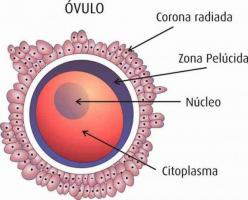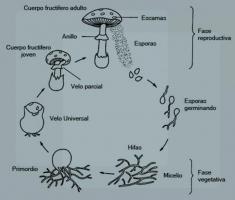Classification of ECOSYSTEMS
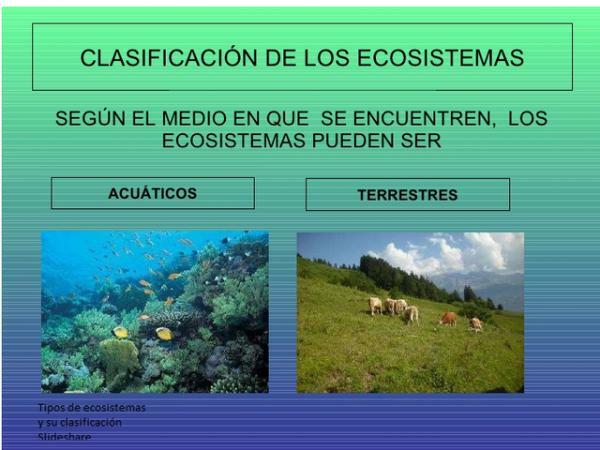
Within the great ecosystem that forms the Earth we can find different sets of living things that coexist to a greater or lesser degree of harmony in a given space. This is called an ecosystem. In this lesson from a TEACHER we will review what an ecosystem is and why it is important to conserve each of its parts, in addition to making a brief review of the six main types of ecosystems that we can find in our planet. Here you have one ecosystem classification so that you can better understand how the planet Earth where we live works.
Index
- What is an ecosystem?
- Classification of ecosystems: aquatic and terrestrial
- Freshwater ecosystems
- Marine ecosystem
- Desert ecosystem: deserts
- Forest ecosystem: forests
- Mountainous ecosystems
- The new ecosystems: artificial ecosystems
What is an ecosystem?
A ecosystemis the set formed by the living beings that inhabit a certain community, that is, all living beings (animals, plants, bacteria, fungi, etc.) that we can find in a place and the relationships that occur between them and with the environment in which they live (community).
It is important to be clear that an ecosystem is not only made up of the plants and animals of a place, but that also come into play many more components on which your daily life will depend: from living components (biotic components) such as bacteria or fungi that inhabit the soil, water and air to other inert ones such as the soil of the that the plants are nourished or the temperature that all living beings that live in a given place (abiotic components). Both biotic components and abiotic components are important within an ecosystem since the life of one depends on the other.
There are different types of ecosystems with their characteristics and then we are going to present you the most common classification that is carried out in biology.
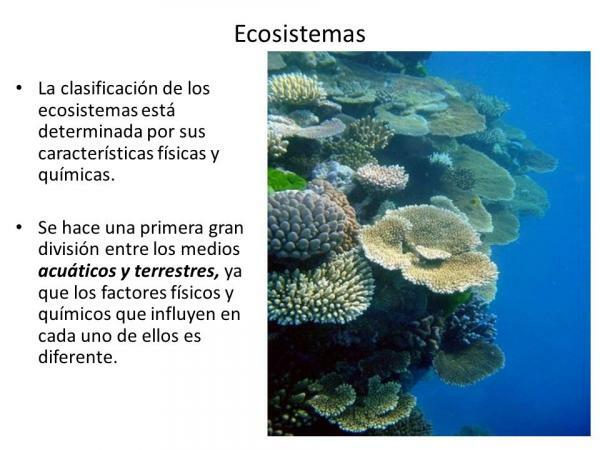
Image: Slideplayer
Classification of ecosystems: aquatic and terrestrial.
When we talk about the classification of ecosystems we can make a first classification, very logical and intuitive according to whether it is formed, mostly, by water or land.
Aquatic ecosystems
On planet Earth, aquatic ecosystems, especially the marine ones, have great extension and richness of species. In fact, it is thought that in the seas and oceans there are a large number of new species, which we have not yet discovered. Aquatic ecosystems can be divided into two large groups: marine ecosystems and freshwater ecosystems.
Marine ecosystems are those that we can find in the seas and oceans, that is, in large extensions of salt water while freshwater are those of rivers, lakes, wells, lagoons and any extension of water that is not salty.
Terrestrial ecosystems
On the other side of the scale are the echoterrestrial systems, which are characterized by the fact that there is a large area of land to support animal and plant life. Terrestrial ecosystems are very varied, but we can basically classify them into three groups: desert, mountain or forest.
Within these we can find different subgroups according to the biotic or abiotic components that characterize them (altitude, temperatures, vegetation, etc).
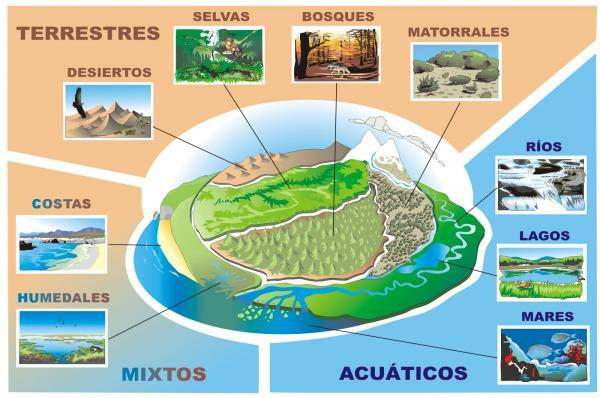
Image: Geo Files
Freshwater ecosystems.
Ecosystems formed by bodies of water with a low concentration of salt (fresh water) are called freshwater ecosystems. Within the freshwater ecosystems we can define three subgroups:
- Lentic ecosystems. They are characterized by being bodies of water of different sizes, with little or no movement from water such as lakes, ponds, ponds, puddles and wells. In this type of ecosystems, oxygen renewal is very poor and in certain cases there is great stratification and we can see the animals and plants distributed at different levels of depth (strata).
- Lotic ecosystems. It is the type of ecosystems formed by rivers and is characterized by being based on bodies of water of a size medium, with great movement due to currents, gravity and unevenness and irregularities of the scenery.
- Wetlands. Wetlands are characterized by being ecosystems that, although they have land, this is usually very humid and muddy since, as the name suggests, they are places with high humidity (both from the ground and in the air).
Freshwater aquatic ecosystems are characterized by the presence of highly adapted plants such as algae or riparian vegetation. In addition, they support a large amount of animal life, both small vertebrates and invertebrates (insects, crustaceans, fish, etc.) as larger animals such as some types of sharks, sturgeons or stripes.
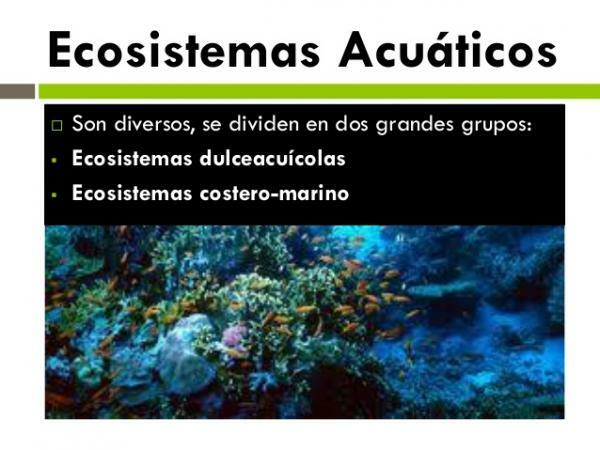
Image: Slideplayer
Marine ecosystem.
The marine ecosystems They are of great importance on our planet since more than 70% of it is covered by water. There are a large number of marine ecosystems, which are classified mainly according to their depth with respect to land level and with the most characteristic animals or plants. ç
An example are the Coral reefs, which revolve around different species of marine coral; another example is that of marine fumaroles, which are characterized by being at great depth, withstanding high pressures and the expulsion of materials and substances from the seabed occurs.
Desert ecosystem: deserts.
The first type of terrestrial ecosystem is the desert or desert ecosystem. This ecosystem is characterized by low rainfall and great thermal amplitude. This makes the animals and plants that appear are very adapted to this medium: the plants have small and thin leaves, with little surface to avoid the loss of water, and some have water deposits like cacti. Animals, on the other hand, also generate water deposits in their bodies, which allow them to migrate or cover their bodies with substances that prevent water loss.
These ecosystems are very fragile to the loss of plants and animals since these are very adapted to the specific conditions that occur in different deserts: the Gobi desert, which spans China and Mongolia, does not have the same animals as deserts Africans.
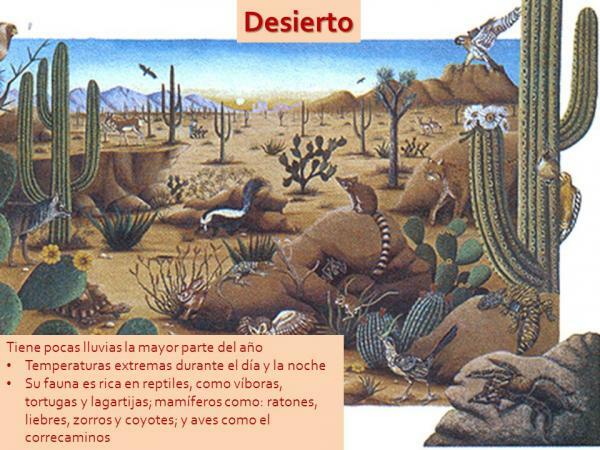
Image: Slideplayer
Forest ecosystem: forests.
The forest ecosystem or woods It is characterized by having abundant and, on some occasions, very varied plant life. Forest ecosystems are characterized by having sufficient rainfall to support a large number of animals and plants, which will depend largely on latitude and altitude:
- Jungle. It is characterized by being in warm or tropical areas, near the equator. With abundant rains and mild temperatures, with little thermal amplitude. In this type of ecosystem there are a large number and variety of plants (trees, shrubs, bushes and herbs) and animals (birds, insects, mammals and everything you can imagine!)
- Temperate forest. It is characterized by being in temperate zones and having an abundant, more or less constant contribution of rain and average temperatures, with some thermal amplitude and the appearance of seasons. These forests can be formed by a majority type of tree (such as coniferous forests) or be mixed. This type of forest is home to a great variety of animals, although they are not very visible since they usually live on the ground, among the trees or even have nocturnal habits.
- Dry forest. This type of forest is characterized by having abundant rainfall, which is concentrated at one time of the year (rainy season) while the rest of the year the rain is rather non-existent (season dry). These forests are mostly deciduous, tropical and subtropical forests and in them we can find a large number of birds and mammals.
- Taiga. The taiga is the most extreme forest ecosystem since it occurs in regions of great latitude or altitude of the planet, where there is little liquid precipitation (rain) and great thermal amplitude. In some of these places, plant life is limited to just four months a year and animals are forced to hibernate to overcome long periods of cold and famine.
Mountain ecosystems.
Mountain ecosystems are those found in mountains of a medium or high altitude. In this type of environment, the appearance of plants and animals is marked by altitude, by areas of shade (shady) and sun (sunny) and, in some cases, by the existence of small masses of Water. Therefore, as in the seas and oceans, in mountainous ecosystems we can observe a stratification, being very frequent that the animals and the plants are more abundant in the low and sunny zones and they are diminishing as we approach the summit. This stratification is especially marked in steep or very high mountains.
Mountain ecosystems are very rich in vegetables of all sizes and we can find from forests to bushes, herbs and shrubs. Due to their plant richness, mountains are also home to great animal biodiversity, from invertebrates that live on the forest floor to goats, wolves or lynxes.

Image: Slideplayer
The new ecosystems: artificial ecosystems.
The artificial ecosystemss are those places and conditions that humans have created artificially. This new habitat has special conditions for life both for us and for the rest of the living beings that surround us. The biggest example are big cities. In large cities live many living beings, from the plants that make up parks and gardens to our pets, passing through some pests such as pigeons, cockroaches or rodents
The artificial ecosystem is characterized by excess food and the absence of predators. In addition, generally, there is a great lack of land and space that is occupied by our vehicles and homes. Due to the large concentration of people, these ecosystems also suffer from a lot of pollution, especially water and land, but also air pollution and noise pollution.
In addition, humans are responsible for the introduction into this type of ecosystems of species that would not occur naturally in them: the invasive alien species. An example is the introduction in Spanish cities of the Argentine parrot, the Florida turtles or the otter rat, which is found in some rivers in Navarra and the Basque Country.
If you want to read more articles similar to Ecosystem classification, we recommend that you enter our category of biology.
Bibliography
- Grumbine, R.E. (1994). What is ecosystem management? Conservation Biology 8 (1): 27-38.
- Maass, J.M. already. Martínez-Yrízar. (1990). Ecosystems: definition, origin and importance of the concept. Sciences (No. Esp.). 4: 10-20.
- Pickett, S.T.A., and M.L. Cadenasso. (2002). The ecosystem as a multidimensional concept: meaning, model, and metaphor. Ecosystems 5: 1–10.
- Ecologists in Action (2003). Species introduced in Spain. Recovered from https://www.ecologistasenaccion.org/5952/especies-introducidas-en-espana/
- Centro de Estudios Cervantinos (s.f) Recovered from https://www.centroestudioscervantinos.es/ecosistemas-lenticos/

